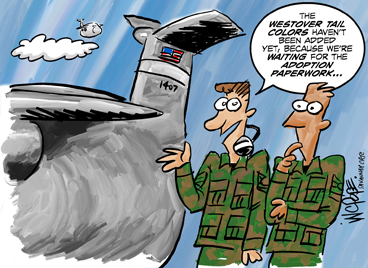It seemed like an unchangeable fact of life—until somebody changed it. The crew chiefs decided to store their tools in the shelters, near at hand. This simple step freed up two maintenance-man-hours per day. That’s significant, given the amount of time required to keep old F-16s combat-ready.
 |
Simple, common-sense steps are exactly what Secretary of the Air Force Michael W. Wynne had in mind when he launched Air Force Smart Operations for the 21st Century in March 2006. “AFSO 21,” as it is called, has a simple goal: greater efficiency.
Reasons abound. There’s a war on. The service’s acquisition accounts are billions short. End strength is declining. The Air Force must make the most of what it has got. USAF, borrowing the concept from industry, is pushing AFSO 21 to free up manpower, time, and money for more productive uses.
The goals are concrete—improve productivity and readiness. Specifically, AFSO 21 aims to:
- Deep-six stupid, unnecessary tasks.
- Keep more equipment ready for service.
- Shorten response times.
- Eliminate accidents, injuries, and breakdowns.
- Cut energy costs.
The Air Force, like every large bureaucracy, must battle lethargy, precedent, and indifference to pull this off. AFSO 21 remains a source of confusion despite a full-scale campaign to explain it. A recent Internet search for AFSO 21 returned 6,000 hits on Air Force Web sites alone, but the information is often confusing and contradictory.
Part of the problem is that AFSO 21 and its descriptions are laden with jargon and buzzwords. Lean. Six Sigma. Theory of constraints. Business process re-engineering. Just-in-time inventory. Blah, blah, blah.
“Lean” means cutting fat—eliminating whatever action produces nothing. Done correctly, less work is performed for the same effect, freeing time and resources for other jobs. Six Sigma and the other business practices refer to eliminating defects, bottlenecks, and other limitations.
AFSO 21 gives USAF an organized way to improve efficiency by encouraging and allowing efficency initiatives without layers and layers of review and comment.
Many AFSO 21 projects so far simply required putting the right equipment in the right place. It really made no sense for airmen running the armory at Incirlik AB, Turkey, to spend an hour assembling equipment from different sites each time they had to equip a new security forces detail. Rifles, radios, and night vision goggles were spread throughout the armory. Incirlik airmen decided to move these items close to the distribution window, halving the time needed for each change of shift.
AFSO 21 encourages airmen to eliminate actions that don’t add value. Walking back and forth doesn’t add value.
In bygone days, maintainers at Aviano AB, Italy, who wanted to work on an F-16 would have to go get, transport, set up, and move ladders around the fighter. Somebody realized you could set up a scaffold and eliminate all of this wasted motion. The change helped cut two days from a seven-day-long repair process.
At Hanscom Clinic in Massachusetts, medical workers sought ways to streamline patient care. One step: Standardization of supplies kept in exam rooms. Now, medical technicians shouldn’t have to hunt down gauze or tongue depressors.
Last March, the 379th Air Expeditionary Wing in Southwest Asia declared that the wing’s AFSO 21 initiatives had saved nearly $20 million, enough to pay for a new MQ-1 Predator.
The Air Force is pushing AFSO 21 down to the lowest levels because it is the airmen performing the jobs who see the inefficiencies. They are often the ones whose lives are made easier by eliminating wasteful action.
USAF is only too aware that bureaucracies have a way of thwarting progress. “The desired effect is not the number of events or the number of personnel trained,” wrote Ronald C. Ritter, the senior civilian AFSO 21 manager. “It’s about the operational impact.”
Most commercial enterprises fail when they try to streamline their operations, said retired CMSgt. Joe Harrison, who is also an AFSO 21 instructor at Dover AFB, Del. “The employees never embraced the culture.”
Yet to be seen is whether the Air Force can sustain the momentum and bring further gains. Stay tuned.
